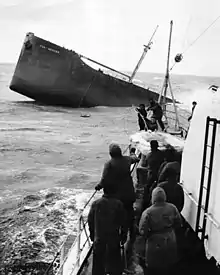SS Fort Mercer
SS Fort Mercer was a Type T2-SE-A1 tanker built by Sun Shipbuilding & Drydock Co., at Chester, Pennsylvania in October 1945. SS Fort Mercer (hull number 534), was built under a Maritime Commission contract and launched on October 2, 1945. With World War II ending on August 15, 1945, Fort Mercer did not serve in the war. Fort Mercer was owned and operated by the Trinidad Corporation of New York.[1][2]
| History | |
|---|---|
| Name | SS Fort Mercer |
| Namesake | Fort Mercer |
| Builder | Sun Shipbuilding & Drydock Co., Chester, Pennsylvania |
| Laid down | June 28, 1945 |
| Launched | October 2, 1945 |
| Acquired | October 31, 1945 |
| Fate | Foundered February 18, 1952 |
| General characteristics | |
| Type | T2-SE-A1 tanker |
| Displacement |
|
| Length | 523 ft 6 in (159.56 m) (as built) |
| Beam | 68 ft (21 m) |
| Draft | 30 ft (9.1 m) |
| Propulsion | Turbo-electric, single screw, 8,000 hp (5,966 kW) |
| Speed | 15 knots (28 km/h) |
| Capacity | 140,000 barrels (22,000 m3) (as built) |
Loss and aftermath

On February 18, 1952, Fort Mercer, full of kerosene and fuel oil, first cracked and then broke in two in a gale, 30 miles (48 km) east of Chatham, Massachusetts. Captain Frederick Paetzel radioed out for help, reporting 68-foot (21 m) waves were hitting the ship. When she broke in two, nine officers and crew were on the bow section and 34 crewmen were on the stern section, with the radio and engine still working. The United States Coast Guard vessels Eastwind and Unimak that were near Nantucket, Massachusetts about 120 miles (190 km) away headed to the two Fort Mercer sections. A Coast Guard PBY aircraft out of Coast Guard Air Station Salem was sent to look for the ship, but did not find it. The Coast Guard vessels Yakutat and Acushnet, using liferafts and surfboats rescued four men from the bow. Only five members of Fort Mercer's 43 man crew were lost, all trapped in the sinking bow.[3][4]
The stern of Fort Mercer, which remained afloat, was towed to Newport, Rhode Island, outfitted with a new bow and rechristened San Jacinto. The new ship was 41 feet (12 m) longer and expanded from 26 tanks to 29 tanks. The ship again split in half in 1964 and again was rebuilt, renamed this time The Pasadena. The Pasadena was partially salvaged and mostly scrapped in 1983.[1][5][6][7]
In the same storm that broke Fort Mercer in two, SS Pendleton, also a T2 tanker, broke up about 20 miles (32 km) away. Daring rescues by the Coast Guard Lifeboat CG 36500 carried out of Pendleton's stern 32 survivors of 33. After grounding, Pendleton's bow was boarded a week later. Of the eight victims stranded on this section, only one frozen body was recovered.
See also
- Daniel Webster Cluff United States Coast Guard officer
- The Finest Hours - Movie
References
- Visser, Auke. "Fort Mercer". Auke Visser's Famous T - Tankers Pages. Auke Visser. Retrieved September 30, 2014.
- usni.org, Triumph and Tragedy off Cape Cod, By Michael Tougias, October 2016 Naval History Magazine
- The Finest Hours : The True Story of the U.S. Coast Guard's Most Daring Sea Rescue, Mike J. Tougias and Casey Sherman, 2009
- "Pendleton Rescue". United States Coast Guard. Retrieved September 30, 2014. (The story of Pendleton's loss and rescue of surviving crewmen is told in the 2016 film, The Finest Hours.)
- Marine engineering, The Log, Volume 49, Page 40, 1954
- The strange saga of the two halves of the SS Fort Mercer, FREDERICK N. RASMUSSEN, The Baltimore Sun, March 15, 2009
- coastguardnews.com, Coast Guard commemorates Cutter Eastwind tragedy, Jan 20th, 2016